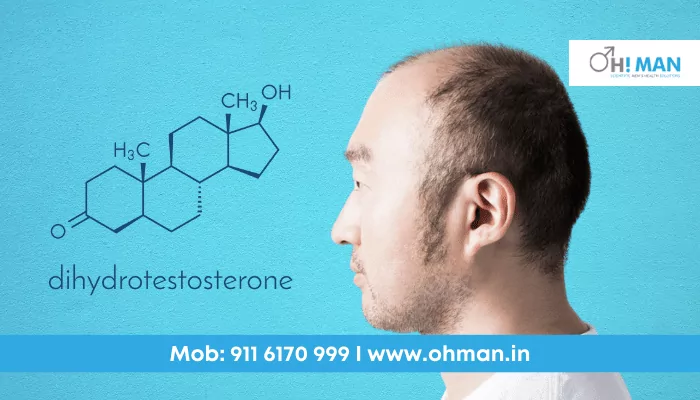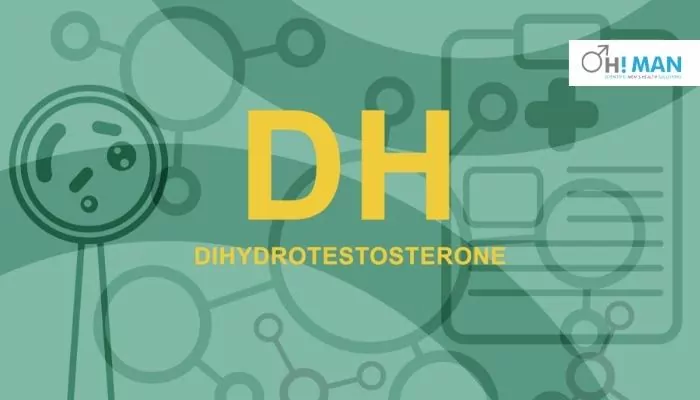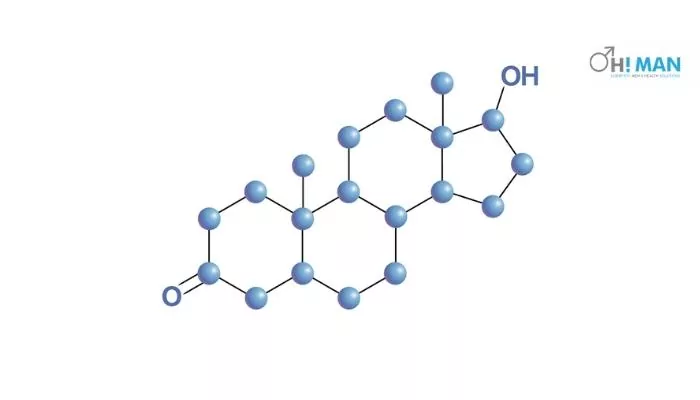What is Dihydrotestosterone(DHT) And Role on Your Health?
What is Dihydrotestosterone(DHT) And Role on Your Health?

Dihydrotestosterone is a metabolite of testosterone, and it exhibits similar but stronger effects. Further, DHT is three to six times stronger than testosterone, and both hormones can be classified as androgens. DHT is first created in the organs that it is being used, like the prostate, and then converts to testosterone by the enzyme 5-alpha reductase.
The DHT, like any other male hormone, is vital in male sexual development and involves the sexual differentiation and growth of organs during embryonic life. DHT promotes sebaceous gland activity, prostrate growth, facial, body, pubic hair growth, and male pattern baldness throughout adulthood and adolescence.
DHT, in short, is one of the hormones which makes you male as a man during the early stages of your life.
Let’s understand the relationship between age and dihydrotestosterone levels.
A well-known clinical study examined serum levels in 78 men between 12 and 89. The groups were: 20-39, 40-59, 60-79, and 80-89.
These four age groups had the following mean +/– SEM (standard error in the mean) measurements:
- 20-39 years = 98 + 12 serum DHT (ng/100 ml)
- 40-59 years = 91 +/- 9 serum DHT (ng/100 ml)
- 60-79 years = 82 +/- 7 serum DHT (ng/100 ml)
- 80-89 years = 54 +/- 15 serum DHT (ng/100 ml)
So, this information clearly states that as a man ages, the DHT levels start to fall.
Let’s understand more about the DHT hormone.
Table of Content –
What is DHT?
Dihydrotestosterone a sex hormone or androgen that helps develop “male” sex characteristics such as body hair, is an androgen, and it can also cause hair loss faster than you would like.
The testes, prostate (in men), and ovaries (in ladies) convert almost 10% of testosterone to dihydrotestosterone each day. However, this figure is lower before puberty.
It is believed that increased dihydrotestosterone levels may start puberty among boys. Further, this could develop the genitals (penis and testes, scrotum) and the growth of pubic hair and body hair. It is believed to cause the prostate to develop, and it may combine with Increase testosterone for achieving various male characteristics.
As mentioned above, dihydrotestosterone has much greater potency than testosterone. Additionally, the body can achieve several benefits of testosterone after converting it into dihydrotestosterone.
Talking about the functions of DHT, Dihydrotestosterone can have numerous effects on the body. It is a precursor to other steroid hormones and serves as a stronger version of testosterone. Although most people don’t need to be concerned about their DHT levels, excessive amounts can lead to hair loss. DHT can block the essential nutrients from reaching hair follicles. So this causes hair to shrink, stop growing and eventually become bald. DHT can also lead to hirsutism or female pattern baldness. The absence of DHT production can cause differences in sexual differentiation, such as androgen insensitivity syndrome.
Effects When The Dihydrotestosterone Levels Falls
While high levels of DHT may increase your risk of certain conditions, too much DHT can cause problems with your sexual development during puberty.
All sexes may experience delays in puberty if they have low DHT. Low DHT does not appear to affect women. However, it may cause problems in men with low DHT.
- Late or incomplete sex organs development – the penis and testes
- Changes in the body fat distribution can lead to conditions like Gynecomastia
- Increased risk of developing aggressive prostatitis
Why does DHT affect people differently?
It is possible to inherit your predisposition for hair loss from your parents.
If your father has a male balding pattern and you are a male, you will likely experience a similar balding pattern as you get older. DHT can cause follicle shrinking in men prone to male-pattern baldness. So, you may experience DHT hair loss.
Your head size and shape may influence how fast DHT shrinks your hair follicles.

Effects Of High/Low Dihydrotestosterone Levels On Males
In Benign Prostatic Hyperplasia, high DHT levels play a role
Although DHT is not a risk factor for prostate cancer, studies have shown that excessive androgen hormone levels could lead to benign prostatic hyperplasia (more commonly known as enlarged prostate). Research shows that the balance of the androgen signalling axis maintains healthy prostates. So, this includes:
- Testosterone production in the testes and adrenal glands
- The conversion of that testosterone into DHT
- DHT transportation to tissues all over the body
- The binding of DHT to androgen receptors
DHT is essential for the prostate’s healthy development and growth. However, excessive levels can cause the tissue to grow in the prostate.
The most prevalent condition with the prostate amongst men above 50 is benign prostatic hyperplasia. Some symptoms of benign prostate hyperplasia:
- Urinary frequency and urgency increase
- It may be difficult for a weak urine stream to begin.
- Frequent urination in the middle of the night
- Urinary Incontinence or urinary retention
Although none of these symptoms is life-threatening, they can lead to severe complications such as damage to the bladder or kidneys.
Fertility
DHT’s effects on male fertility are still not apparent. DHT is produced by enzymes present in the prostate, penis, and scrotum, and they are not found in the testes, and DHT is not required for spermatogenesis.
Some data suggest that 5-alpha reductase inhibition may affect sperm production temporarily. In some studies, these drugs have link to decreased sperm count or reduced semen volume, and it has also been linked with lower sperm motility.
These effects are thankfully reversible if you pause the treatment. Other studies have not shown any changes in the sperm parameters after low-dose finasteride treatment. Therefore, further research is vital.
High levels of DHT in females
Hair loss isn’t limited to men, and hair loss can also occur in women when there is an increase in DHT. Female pattern hair loss (FPHL) can also occur in women with too much DHT.
High DHT symptoms in women include increased facial hair growth, increased pubic hair growth, and/or more severe acne.
Consider taking a DHT blocking if you have excessive DHT. Natural blockers can help ensure you don’t have excessive DHT in your body and reduce health risks.
DHT may causes male pattern baldness in men
DHT increases can cause hair loss because the hormone causes the hair follicles to shrink. Further, this causes hair to become thinner and more brittle because of its shorter growing cycle and longer resting period. Your scalp will stop growing new hair, and the hair you do have will eventually fall out, contributing to male pattern baldness. Hair loss will occur in the usual pattern of androgenetic alopecia.

DHT may increase acne
Acne is a common cause of hormonal imbalances, especially when there is an excessive DHT. DHT can cause increased oil production 4, leading to skin blemishes.
Bottom Line
Low levels of dihydrotestosterone can cause dramatic changes in men. For example, if there is not enough dihydrotestosterone in the womb, male fetuses may not be masculinized. Additionally, they may have genitalia similar to girls their age. Further, boys with little dihydrotestosterone will experience regular changes in puberty, such as increased muscle growth and produce sperm. However, they might not have the usual genital development or hair growth.
Frequently Asked Questions
What are the four effects of dihydrotestosterone?
DHT promotes prostate growth, male pattern hair loss, sebaceous gland activity, and body, facial, and pubic hair growth.
What are the signs of high DHT?
These are the signs of high DHT in men.
- Acne
- Receding hairline.
- High levels of DHT can cause hair loss at the Crown and Temples.
Does high DHT mean high testosterone?
The amount of testosterone in the body determines how much dihydrotestosterone is present each day. As testosterone levels rise, more of it converts to dihydrotestosterone. Therefore, levels of dihydrotestosterone also rise.
How does dihydrotestosterone become testosterone?
DHT, the most potent hormone of all the androgens, is also considered pure androgen because it cannot be converted into estrogen. It primarily forms in the peripheral tissues of your body, where it exerts its effects. The five alpha-reductase enzymes in these target tissues convert testosterone to DHT.



